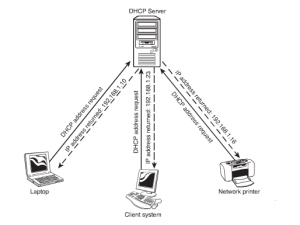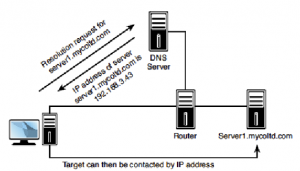N10-007 Install and configure the following networking services/applications
DHCP
The full form of DHCP is Dynamic Host Configuration Protocol. This is the easiest way of assigning TCP/IP information to client systems. Protocol is the method adopted by computers to communicate amongst themselves. Specific settings need to be ensured for a system to enable a system to connect to the network. Computers that are using TCP/IP need to have an IP address to be recognized on the network.
An IP address consists of four octets, or four sets of 8 bit. The decimal form is used to represent it, for example, 192.168.2.1. It is a unique number that is assigned to a PC and it must be within a certain range to allow the PC to connect to other systems. The time of entering IP addresses manually into the network settings are long past. These are known as manual or static IP addresses. Manual IP addresses prove a challenge for the simple reason that they are time consuming and have to be kept unique as duplication of the address prevents successful connection to the system that was allotted the address at the first stage. In larger networks this is all the more a daunting task as computers are moved, replaced or even taken out of the network system. In such situations the DHCP plays an important role.
The DHCP performs the function of assigning IP addresses automatically; as a result the administrator is not required to do this job. With a DHCP server on the network, the workstation boots up, request for an IP address is issued to the server and the server responds by issuing an IP address, the receipt of the address is acknowledged by the workstation. As the address is issued for sometime it is known as a lease. The workstation now has all the information that it requires to be a part of the network. Because of their ability to act automatically, DHCP servers are preferred in client/server setups. The likelihood of more than one DHCP server in an environment is also common.
The protocol is defined in RFC 2131. It allows IP addresses to be defined in ranges. This is done on a system running a DHCP server application. The system asks for an address when a system that has been configured as a DHCP client is initialized. The address is assigned from the DHCP scope, for a definite period of time. This is known as a lease. The figure given below illustrates the working of a DHCP.

Figure 12: Working of DHCP
Time and again the lease is renewed. The lease expires when no renewal is possible. The DHCP server can supply more information than just IP address and the subnet mask. It depends on how the DHCP has been implemented. The other information that it can supply is the default gateway, the DNS information. It also performs the function of reservation. Reservation ensures that while using a DHCP the IP address remains the same.
At various points during the lease (normally the 50 percent and 85 percent points), the client attempts to renew the lease from the server. If the server cannot perform a renewal, the lease expires at 100 percent, and the client stops using the address.
In addition to an IP address and the subnet mask, the DHCP server can supply many other pieces of information; although, exactly what can be provided depends on the DHCP server implementation. In addition to the address information, the default gateway is often supplied, along with DNS information.
In addition to having DHCP supply a random address from the scope, you can configure it to supply a specific address to a client. Such an arrangement is known as a reservation. Reservations are a means by which you can still use DHCP for a system but at the same time guarantee that it always has the same IP address. DHCP can also be configured for exclusions. In this scenario, certain IP addresses are not given out to client systems.
The advantages of using DHCP are numerous. First, administrators do not need to manually configure each system. Second, human error such as the assignment of duplicate IP addresses is eliminated. Third, DHCP removes the need to reconfigure systems if they move from one subnet to another, or if you decide to make a wholesale change in the IP addressing structure. The downsides are that DHCP traffic is broadcast-based and thus generates network traffic—albeit a small amount. Finally, the DHCP server software must be installed and configured on a server, which can place additional processor load (again, minimal) on that system. From an administrative perspective, after the initial configuration, DHCP is about as maintenance-free as a service can get, with only occasional monitoring normally required.
DNS
DNS performs an important function on TCP/IP-based networks. It resolves hostnames, such as www.quepublishing.com, to IP addresses, such as 209.202.161.67. Such a resolution system makes it possible for people to remember the names of and refer to frequently used hosts using easy to remember hostnames rather than hard-to-remember IP addresses.
In the days before the Internet, the network that was to become the Internet used a text file called HOSTS to perform name resolution. The HOSTS file was regularly updated with changes and distributed to other servers.
Like other TCP/IP-based services, DNS is a platform-independent protocol.
Therefore, it can be used on Linux, UNIX, Windows, NetWare, and almost every other platform.
The host’s IP address is listed, along with the corresponding hostname. You can add to a HOSTS file aliases of the server names, which in this example are s1 and mailserver. All the entries must be added manually, and each system to perform resolutions must have a copy of the file.
Even when the Internet was growing at a relatively slow pace, such a mechanism was both cumbersome and prone to error. It was obvious that as the network grew, a more automated and dynamic method of performing name resolution was needed. DNS became that method.
DNS solves the problem of name resolution by offering resolution through servers configured to act as name servers. The name servers run DNS server software, which enables them to receive, process, and reply to requests from systems that want to resolve hostnames to IP addresses. Systems that ask DNS servers for a hostname-to-IP address mapping are called resolvers or DNS clients. Figure 13 shows the DNS resolution process. In this example, the client asks to reach the first server at mycoltd.com; the router turns to the DNS server for an IP address associated with that server; and after the address is returned, the client can establish a connection.

Figure 12
Because the DNS namespace (which is discussed in the following section) is large, a single server cannot hold all the records for the entire namespace. As a result, there is a good chance that a given DNS server might not resolve the request for a certain entry. In this case, the DNS server asks another DNS server if it has an entry for the host.
DNS Entries
Although the most common entry in a DNS database is an A (address) record, which maps a hostname to an IP address, DNS can hold numerous other types of entries as well. Some are the MX record, which can map entries that correspond to mail exchanger systems, and CNAME (canonical record name), which can create alias records for a system. A system can have an A record and then multiple CNAME entries for its aliases. A DNS table with all these types of entries might look like this:
fileserve.mycoltd.com IN A 192.168.33.2
email.mycoltd.com IN A 192.168.33.7
fileprint.mycoltd.com IN CNAME fileserver.mycoltd.com
mailer.mycoltd.com IN MX 10 email.mycoltd.com
As you can see, rather than map to an actual IP address, the CNAME and MX record entries map to another host, which DNS in turn can resolve to an IP address.
DNS Records
Each DNS name server maintains information about its zone, or domain, in a series of records, known as DNS resource records. There are several DNS resource records; each contains information about the DNS domain and the systems within it. These records are text entries stored on the DNS server.
Some of the DNS resource records include the following:
- Start of Authority (SOA): A record of information containing data on DNS zones and other DNS records. A DNS zone is the part of a domain for which an individual DNS server is responsible. Each zone contains a single SOA record.
- Name Server (NS): Stores information that identifies the name servers in the domain that store information for that domain.
- Canonical Name (CNAME): Stores additional hostnames, or aliases, for hosts in the domain. A CNAME specifies an alias or nickname for a canonical hostname record in a domain name service (DNS) database. CNAME records give a single computer multiple names (aliases).
- Pointer (PTR): A pointer to the canonical name, which is used to perform a reverse DNS lookup, in which case the name is returned when the query originates with an IP address.
- IPv6 Address (AAAA): Stores information for IPv6 (128-bit) addresses. It is most commonly used to map hostnames to an IP address for a host.
- Mail Exchange (MX): Stores information about where mail for the domain should be delivered.
The importance of DNS, particularly in environments in which the Internet is heavily used, cannot be overstated. If DNS facilities are not accessible, the Internet effectively becomes unusable, unless you can remember the IP addresses of all your favorite sites.

Recent Comments